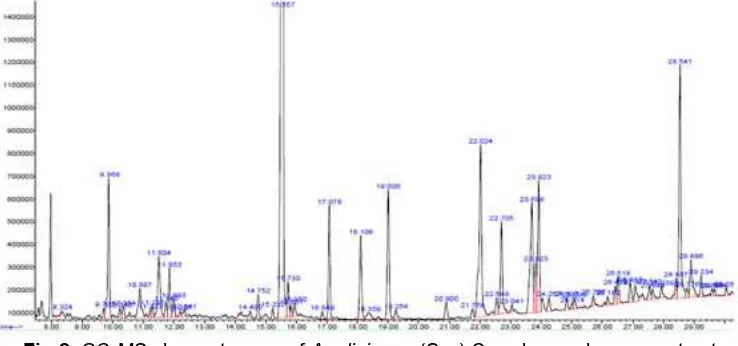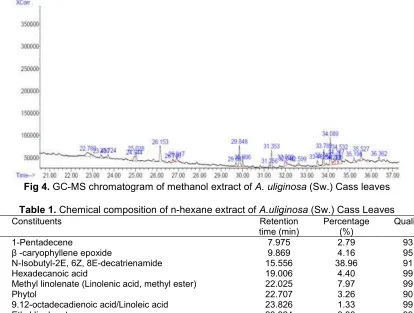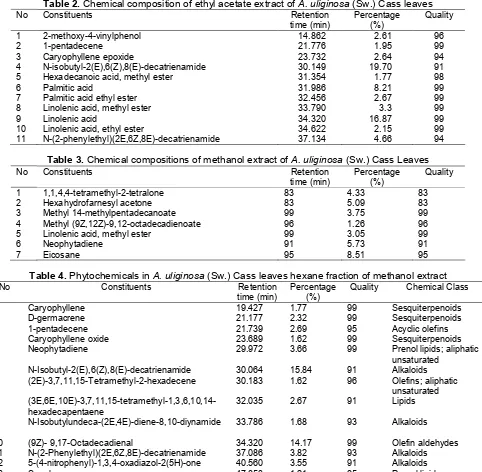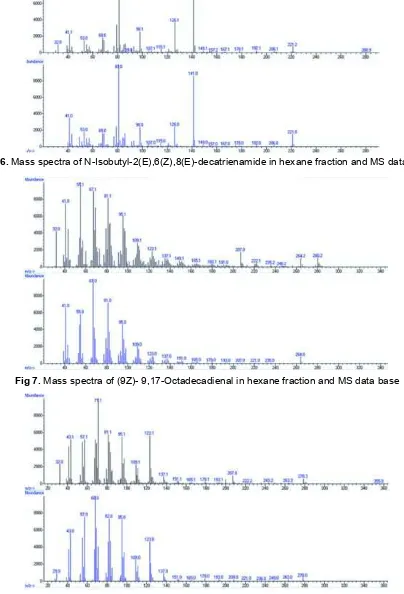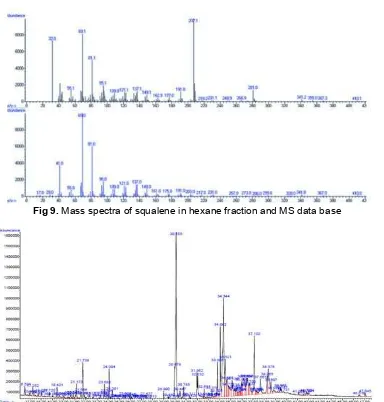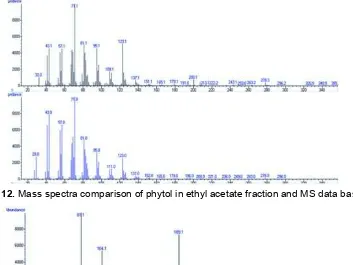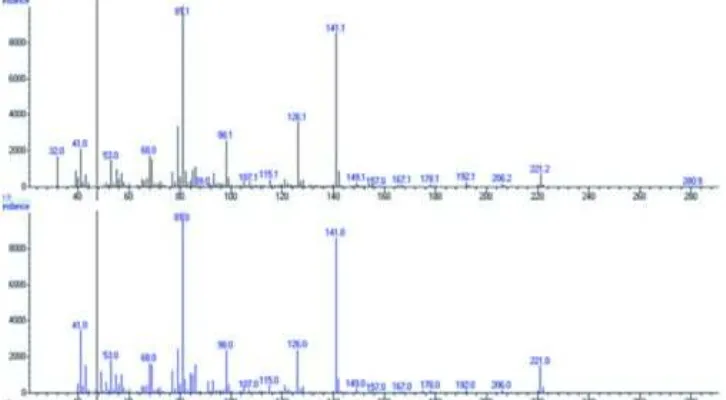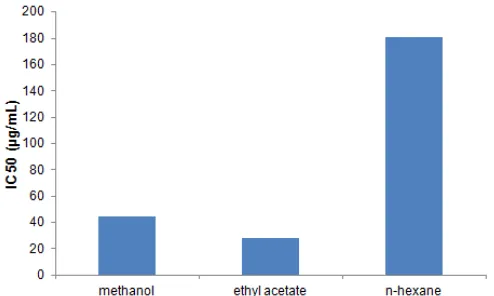Chemical Composition, Phytochemical Screening and Antioxidant Activity of
Acmella
uliginosa
(Sw.) Cass Leaves
Askal Maimulyanti
1,*, Anton Restu Prihadi
1, and Iwan Safrudin
2 1Department of Chemical Analysis, Academy of Analytical Chemistry (AKA) Jl. Pangeran Sogiri No. 283 Tanah Baru, Bogor 16158, Indonesia
2
Department of R&D, PT Indesso Aroma, Jl. Alternatif Cibubur-Cileungsi Km. 9, Bogor 16820, Indonesia
Received April 3, 2015; Accepted December 2, 2015
ABSTRACT
Acmella uliginosa (Sw.) Cass is widely used in traditional medicine and used in the treatment of many diseases. Extraction of component in leaves of Acmella uliginosa used methanol, ethyl acetate and n-hexane solvent. The percentage yield of extract from the leaves in methanol, ethyl acetate and n-hexane were 6.50, 0.49, and 0.66, respectively. Analysis of component in various extracts of Acmella uliginosa (Sw.) Cass leaves used Gas Chromatography-Mass Spectrometry (GC-MS). The various classes of phytochemicals were identified from fractions of methanolic leaves extract by GC-MS. Qualitative analysis of phytochemical constituents in methanol, ethyl acetate and n-hexane extract were tannins, flavonoids, saponin, alkaloid and steroid. Antioxidant activity of Acmella uliginosa leaves from Indonesia was carried out by using 1,1,diphenyl-2-picryl-hydrazine (DPPH) free radical scavenging assay. The IC50of three extract was calculated. A comparative study determined that Acmella uliginosa in ethyl acetate extract showed the highest antioxidant potential (IC50= 28.09 µg/mL) compared to methanol extract (IC50= 44.31 µg/mL) and n-hexane extract (181.23 µg/mL) against DPPH free radicals.
Keywords:Acmella uliginosa (Sw.) Cass; chemical composition; phytochemical; antioxidant
ABSTRAK
Acmella uliginosa (Sw.) Cass adalah tanaman yang biasa digunakan sebagai obat tradisional untuk menyembuhkan berbagai penyakit. Ekstraksi komponen dalam daun Acmella uliginosa masing-masing menggunakan pelarut metanol, etil asetat dan n-heksana. Rendemen yang diperoleh dari ekstrak metanol, etil asetat dan n-heksana adalah 6,50, 0,49, dan 0,66. Analisis komponen dalam berbagai ekstrak daun Acmella uliginosa (Sw.) Cass menggunakan Kromatografi Gas-Spektrometri Massa (KG-SM). Kelas-kelas fitokimia telah diidentifikasi dari fraksi-fraksi yang berasal dari ekstrak metanol daun. Uji fitokimia secara kualitatif dalam metanol, etil asetat dan n-hexane menunjukkan adanya golongan senyawa tanin, flavonoid, saponin, alkaloid and steroid. Aktivitas antioksidan dari daun Acmella uliginosa menggunakan 1,1,diphenyl-2-picryl-hydrazine (DPPH). Nilai IC50 dari ketiga ekstrak memperlihatkan ekstrak dalam etil asetat memberikan aktifitas yang paling tinggi (IC50 = 28,09 µg/mL) dibandingkan dengan ekstrak metanol (IC50= 44,31 µg/mL) dan ekstrak n-heksan (181,23 µg/mL).
Kata Kunci:Acmella uliginosa (Sw.) Cass; komposisi kimia; fitokimia; antioksidan
INTRODUCTION
Acmella uliginosa (Sw.) Cass which is locally known in Indonesia as “jotang” is an edible herb traditionally used in the treatment of many diseases and well known for its culinary use as spice. It is an annual herb belongs to family Asteraceae [1]. The roots, flower heads and whole aerial part yield a compound known as spilanthol which is a powerful insecticide and local anesthetic. Spilanthol is known to posses antibacterial and anti-inflammatory activity [2]. The leaves and flower head contain analgesic, antifungal, antimalarial and antibacterial [3-4]. The leaves of Acmella uliginosahave
Antioxidant constituents of the plant material act as radical scavengers, and help in converting the radicals to less reactive species. Oxidation of biomolecules can cause generation of free radical in body. Natural antioxidants occur in all parts of plants. These antioxidants include carotenoids, vitamins, phenols, flavonoids [10-11]. One such method that is currently popular is based upon the use of the stable free radical diphenylpicrylhydrazyl (DPPH). The molecule of 1,1-diphenyl-2-picryl-hydrazyl is characterized as a stable free radical by virtue of the delocalization of the spare electron over the molecule as a whole, so that the molecules do not dimerise, as would be the case with most other free radicals. One parameter that has been introduced recently for the interpretation of the result from the DPPH method is the “efficient concentration” or IC50 value. This is defined as the concentration of
substrate that causes 50% loss of the DPPH activity [12].
Although a large number of species of spilanthes genus are being ethnomedically for different kinds of diseases throughout the world, very little chemical or biological investigation has been done on Acmella uliginosa (Sw.) Cass from Indonesia. The objective of this research is to identify of the chemical composition, screening phytochemical and antioxidant activity from leaves ofAcmella uliginosa(Sw.) Cass.
EXPERIMENTAL SECTION
Materials
Materials in this experiment were leaves ofAcmella uliginosa, n-hexane, methanol, ethyl acetate, 1,1,diphenyl-2-picryl-hydrazine, hydrochloride, ferric chloride, sodium-gelatin, ethanol, magnesium, dragendorff reagent, mayer reagent and acetic anhydride.
Instrumentation
The instrumentations in this research were Gas Chromatography-Mass Spectrometry analysis were performed using by GC-MS Agilent HP7890-5975C MSD and spectrophotometer pharmaspec UV-1700 (Shimadzu), rotary evaporator.
Procedure
Sample extraction
Fresh flowers of Acmella uliginosa were collected in Ciparay, Bandung in West Java, Indonesia. Authentication of plant species was carried out by Dr. J.S. Rahajoe in Herbarium Bogoriense, Indonesia. Samples were cleaned and washed with fresh water.
250 g of fresh Acmella uliginosa leaves were macerated in 1000 mL of solvent (methanol, ethyl acetate and n-hexane) for five days. Result of extractions were filtered, condensed by rotary evaporator and its used for analysis.
The methanol extract was extracted in succession with normal hexane, ethyl acetate, and normal butanol. The fractions were identified phytochemical compositions by GC-MS.
Analysis by GC-MS
Chemical compositions were analyzed by Gas Chromatography-Mass Spectrometry (GC-MS). Components were identified by matching their mass spectra with those recorded in the mass spectral library. Gas Chromatography-Mass Spectrometry analysis was performed using by GC-MS Agilent HP7890 GC System, Agilent 5975C series GC MSD. GC 7890 with FID detector, FID heater 275 °C, column agilent HP-1 methyl siloxane (30 m x 250µm x 0.25µm film thickness), carrier gas Helium with pressure 2.0244 psi; inlet : split ratio 500:1, total flow 53.1 mL/min, septum purge flow 3 mL/min, gas saver on 20 mL/min after 2 min. Oven temperature was programmed from 100 °C for 10 min, then 5 °C/min to 200 °C, then 10 °C/min for 10 min, total running time was 60 min. The multispectral acquisition parameters : EMV mode was relative, relative voltage was 0, resulting EM voltage was 2506; scan parameters : low mass 30.0, high mass 500.0, threshold 50; MS zones : MS Source 250 °C and MS quadrupole 200 °C, ionization voltage 70 eV, MSD transfer line 300 °C, and integration events 16. Compound identification was done by comparing the Wiley 2008-NIST library and P. Adam data of the peaks with those reported in literature, mass spectra of the peaks with literature data.
Preliminary phytochemical screening
The extracts of following leaves were subjected to different chemical tests for the detection of different phytoconstituents using standard procedures [13]. Test for tannins. A sample of 1 mL of extract was taken in a test tube and then 1 mL of HCl 10% and 1 mL ferric chloride 3% was added and observed for blue-black colouration. Tannin test can use gelatine 10% and sodium-gelatine and observed of precipitation.
Test for saponin. Extract was mixed with 5 mL of distilled water in a test tube and was shaken vigorously. The formation of stable foam was taken as an indication for the presence of saponins.
Fig 1.The yield of various extracts fromuliginosa(Sw.) Cass leaves
Fig 2.GC-MS chromatogram ofA. uliginosa(Sw.) Cass leaves hexane extract
added. The yellow or violet coloration disappears on standing.
Test for alkaloids.Extract was diluted in ethanol 96%, HCl 2 N was added. Solution was filtered and the filtrate taken into three test tube. Each of test tubes was identified by reagent of dragendorf and mayer. The positive result is white or yellow color for mayer reagent and red color for dragendorff.
Test for steroids.Acetic anhydride 2 mL was added to 0.5 mL crude extract of plant sample with 2 mL H2SO4.
The color change from violet to blue or green in sample indicates the presence of steroids.
Antioxidant Activity
The antioxidant activity was evaluated using the free radical scavenging activity of the (DPPH) method. DPPH is free radical, but stable. The DPPH solution is initially violet in color which fades when antioxidants donated hydrogen. The change in color is monitored by spectrophotometer and DPPH free radical scavenging activity is calculated [14].
A stock solution of 0.1 mM DPPH in methanol was made. Test sample of extract were made at 10, 20, 30, and 40 µg/mL in methanol and ethyl acetate. Test
sample of n-hexane extract made at 100, 200, 300, 400, and 500 µg/mL. The absorbance was measured at 517 nm by spectrophotometer (UV-VIS Shimadzu). After 30 min and % scavenging was calculated by the equation.
where, Ao = Absorbance of DPPH solution and AT =
Absorbance of test or reference sample. The % scavenging was then plotted against concentration and regression equation was obtained to calculate IC50. IC50
is defined as the total antioxidant necessary to decrease the initial DPPH radical by 50%.
RESULT AND DISCUSSION
Chemical Composition
Fig 3.GC-MS chromatogram of ethyl acetate extract ofA. uliginosa(Sw.) Cass leaves
Fig 4.GC-MS chromatogram of methanol extract ofA. uliginosa(Sw.) Cass leaves
Table 1.Chemical composition of n-hexane extract ofA.uliginosa(Sw.) Cass Leaves
No Constituents Retention
time (min)
Percentage (%)
Quality
1 1-Pentadecene 7.975 2.79 93
2 β -caryophyllene epoxide 9.869 4.16 95
3 N-Isobutyl-2E, 6Z, 8E-decatrienamide 15.556 38.96 91
4 Hexadecanoic acid 19.006 4.40 99
5 Methyl linolenate (Linolenic acid, methyl ester) 22.025 7.97 99
6 Phytol 22.707 3.26 90
7 9.12-octadecadienoic acid/Linoleic acid 23.826 1.33 99
8 Ethyl linolenate 23.924 3.86 99
9 N-(2-phenylethyl)(2E,6Z,8E), decatrienamide 28.542 7.81 93
10 Eicosane 31.506 1.39 97
extractable component of different polarities. The Fig. 2, 3, and 4 showed the chromatogram of GC-MS from the various extracts ofAcmella uliginosaleaves and Table 1, 2, and 3 summarized the qualitative and quantitative GC-MS analysis.
A total of 10 compounds (Table 1) were identified for hexane extract of Acmella uliginosa. The main
Table 2.Chemical composition of ethyl acetate extract ofA. uliginosa(Sw.) Cass leaves
1 2-methoxy-4-vinylphenol 14.862 2.61 96
2 1-pentadecene 21.776 1.95 99
3 Caryophyllene epoxide 23.732 2.64 94
4 N-isobutyl-2(E),6(Z),8(E)-decatrienamide 30.149 19.70 91
5 Hexadecanoic acid, methyl ester 31.354 1.77 98
6 Palmitic acid 31.986 8.21 99
7 Palmitic acid ethyl ester 32.456 2.67 99
8 Linolenic acid, methyl ester 33.790 3.3 99
9 Linolenic acid 34.320 16.87 99
10 Linolenic acid, ethyl ester 34.622 2.15 99
11 N-(2-phenylethyl)(2E,6Z,8E)-decatrienamide 37.134 4.66 94
Table 3.Chemical compositions of methanol extract ofA. uliginosa(Sw.) Cass Leaves
No Constituents Retention
time (min)
Percentage (%)
Quality
1 1,1,4,4-tetramethyl-2-tetralone 83 4.33 83
2 Hexahydrofarnesyl acetone 83 5.09 83
3 Methyl 14-methylpentadecanoate 99 3.75 99
4 Methyl (9Z,12Z)-9,12-octadecadienoate 96 1.26 96
5 Linolenic acid, methyl ester 99 3.05 99
6 Neophytadiene 91 5.73 91
7 Eicosane 95 8.51 95
Table 4.Phytochemicals inA. uliginosa(Sw.) Cass leaves hexane fraction of methanol extract
No Constituents Retention
time (min)
Percentage (%)
Quality Chemical Class
1 Caryophyllene 19.427 1.77 99 Sesquiterpenoids
2 D-germacrene 21.177 2.32 99 Sesquiterpenoids
3 1-pentadecene 21.739 2.69 95 Acyclic olefins
4 Caryophyllene oxide 23.689 1.62 99 Sesquiterpenoids
5 Neophytadiene 29.972 3.66 99 Prenol lipids; aliphatic
unsaturated
6 N-Isobutyl-2(E),6(Z),8(E)-decatrienamide 30.064 15.84 91 Alkaloids
7 (2E)-3,7,11,15-Tetramethyl-2-hexadecene 30.183 1.62 96 Olefins; aliphatic
unsaturated 8
(3E,6E,10E)-3,7,11,15-tetramethyl-1,3,6,10,14-hexadecapentaene
32.035 2.67 91 Lipids
9 N-Isobutylundeca-(2E,4E)-diene-8,10-diynamide 33.786 1.68 93 Alkaloids
10 (9Z)- 9,17-Octadecadienal 34.320 14.17 99 Olefin aldehydes
11 N-(2-Phenylethyl)(2E,6Z,8E)-decatrienamide 37.086 3.82 93 Alkaloids
12 5-(4-nitrophenyl)-1,3,4-oxadiazol-2(5H)-one 40.560 3.55 91 Alkaloids
13 Squalene 47.053 1.21 95 Prenol lipids
The ethyl acetate extract showed the presence of 11 organic compounds (Table 2). The major of phytocompounds identified were N-isobutyl-2(E),6(Z),8(E) decatrienamide (19.70%), followed by linolenic acid (16.87%), and palmitic acid (8.21%). The other compounds were found in minor percentage.
The methanol extract showed 34 peaks in the chromatogram (Fig. 4), however only seven compounds could be identified by GC-MS. The three main compounds identified were eicosane (8.51%), neophytadiene (5.73%), and hexahydrofarnesyl acetone (5.09%).
The result of GC-MS analysis of fractions hexane, ethyl acetate, and normal butanol of methanol extract revealed different phytochemicals composition (sesquiterpenoids, benzenoids, alkaloids, steroids, lipids, and flavonoids) as shown in Tables 4–6. The chromatograms and mass spectra of the extract fractions are in Fig. 5–18.
Table 5.Phytochemicals inA. uliginosa(Sw.) Cass leaves ethyl acetate fraction of methanol extract
1 2-ethoxy-5-[(1E)-1-propenyl]phenol 21.739 2.57 95 Benzenoids (phenol)
2 N-Isobutyl-2(E),6(Z),8(E)-decatrienamide 30.107 15.03 94 Alkaloids
3 N-Isobutylundeca-(2E,4E)-diene-8,10-diynamide 33.807 2.12 94 Alkaloids
4 Phytol 34.061 3.95 91 Prenol lipids
5 (9E)-9-octadecenoic acid 34.342 13.91 98 Unsaturated fatty acid
6 6-methyloctahydro-2H-chromen-2-one 34.666 2.17 86 Flavonoid
7 7-Heptadecyne, 17-chloro- 36.152 3.30 92 Lipid
8 N-(2-Phenylethyl)(2E,6Z,8E)-decatrienamide 37.102 4.11 94 Alkaloids
Table 6.Phytochemicals inA. uliginosa(Sw.) Cass leaves butanol fraction of methanol extract
No Constituents Retention
Time
Percentage (%)
Quality Chemical class
1 N-Isobutyl-2(E),6(Z),8(E)-decatrienamide 30.042 29.80 90 Alkaloids
2 N-Isobutylundeca-(2E,4E)-diene-8,10-diynamide 33.770 3.11 95 Alkaloids
3 Neophytadiene 34.056 7.12 94 Prenol lipids;
aliphatic unsaturated 4 11H-benzo[a]fluoren-11-one, 6a,11a
-dihydro-7,9-dimethoxy-5,6,6a-trimethyl-,
cis-34.710 2.16 90 Policyclic aromatic
5 N-(2-Phenylethyl) (2E,6Z,8E)-decatrienamide 37.081 6.73 90 Alkaloids
6 Cholesta-6,22,24-triene, 4,4-dimethyl-(beta.stigmasterol)
37.340 8.49 91 Steroid
7 (2E)-3-phenyl-N-(2-phenylethyl)-2-propenamide 37.654 2.19 83 Alkaloids
8 5-(4-nitrophenyl)-1,3,4-oxadiazol-2(5H)-one 42.456 3.54 92 Alkaloids
Fig 5.GC-MS chromatogram ofA. uliginosa(Sw.) Cass Leaves hexane fraction of methanol extract
by GC-MS were N-Isobutyl-2(E),6(Z),8(E)-decatrienamide (alkaloid), (9Z)-9,17-Octadecadienal (olefin aldehyde), and neophytadiene (prenol lipids).
The ethyl acetate fraction revealed the presence phytochemicals composition including alkaloid, benzenoid, lipid, flavonoid, fatty acid, and aliphatic unsaturated (prenol lipids). The three main compound identified were N-Isobutyl-2(E),6(Z),8(E)-decatrienamide (alkaloid), (9E)-9-octadecenoic acid (unsaturated fatty acid), and N-(2-Phenylethyl)(2E,6Z,8E)-decatrienamide
(alkaloid). Other phytochemicals constituent was identified in ethyl acetate fraction was 6-methyloctahydro-2H-chromen-2-one as flavonoid compound as shown in Fig. 14, whereas the component in hexane fraction was not identified.
Fig 6.Mass spectra of N-Isobutyl-2(E),6(Z),8(E)-decatrienamide in hexane fraction and MS data base
Fig 7.Mass spectra of (9Z)- 9,17-Octadecadienal in hexane fraction and MS data base
Fig 9.Mass spectra of squalene in hexane fraction and MS data base
Fig 10.GC-MS chromatogram ofA. uliginosa(Sw.) Cass Leaves ethyl acetate fraction of methanol extract
Fig 12.Mass spectra comparison of phytol in ethyl acetate fraction and MS data base
Fig 13.Mass spectra comparison of N-(2-Phenylethyl)(2E,6Z,8E)-decatrienamide in ethyl acetate fraction and MS data base
Fig 15.GC-MS chromatogram ofA. uliginosa(Sw.) Cass Leaves n-butanol fraction of methanol extract
Fig 16.Mass spectra comparison of N-Isobutyl-2(E),6(Z),8(E)-decatrienamide in butanol fraction and MS data base
Fig 18.Mass spectra comparison of beta neophytadiene in butanol fraction and MS data base
Table 7.Phytochemical screening
Phytochemical
Tannins Alkaloid
Extracts
Flavonoids
NaCl+gelatin FeCl3 Saponin dragendorff Mayer Steroid
Methanol ++ ++ ++ ++ - +
-Ethylacetate - + - - - + ++
n-hexane - + - - - ++ +
and Neophytadiene (prenol lipids–aliphatic unsaturated). Beta stigmasterol as steroid compound was not identified in hexane fraction and ethyl acetate fraction.
The main constituent in extract ofAcmella uliginosa is alkamide (alkaloid compounds). The alkamide content was evaluated and higher concentration was observed in leaves. Many of species that contain alkamides have been used in traditional medicines of different civilizations. They are known their pungent taste and for causing itching and salivating. Some species have been used in the treatment of toothache. One of the widest distributed alkamides in these species and responsible for various biological activities is N-Isobutyl-2(E),6(Z),8(E)-decatrienamide which commonly named as spilanthol [15-16]. Spilanthol is used as spices in foods and beverages, a sense stimulus component in a wide range of product such as foods, beverages, fragrance and cosmetic [17].
Phytochemical Screening
The result of the preliminary phytochemical screening was carried out on the methanol, ethyl acetate andn-hexane extracts of the samples and revealed the presence of a wide range of phytoconstituents including tannins, saponins, flavonoids and steroids as showed in Table 7. Phytochemical constituents in methanol extract
were flavonoids, tannins, saponin and alkaloid. Components in ethyl acetate extract were tannins, alkaloid and steroids. The components in hexane extract were tannins, alkaloid and steroid. Identification of phytochemistry indicated that in polar and semi polar contain polyphenol as antioxidant activity.
Antioxidant Activity
DPPH stable free radical method is an easy, rapid and sensitive to survey the antioxidant activity of a specific compound or plant extract. In generally, DPPH scavenging activities increased with increasing phenolic component such as flavonoids, phenolic acids, and phenolic diterpenes. In DPPH assay, the antioxidant was able to reduce the stable radical DPPH to the yellow colored 1,1-diphenyl-1,2-picryl-hydrazine is characterized as a stable free radical by virtue of the delocalization of the spare electron over the molecular a whole. The delocalization also gives rise to the deep violet color, characterized by an absorption band in methanol solution centered at 517 nm [18].
Fig 19. Comparison of % inhibition at different concentration of methanol extract and ethyl acetate extract
Fig 20. % inhibition of hexane extract at different concentration
Fig 21.Inhibition control 50 % (IC50) ofAcmella uliginosa
(Sw.) Cass leaves
decrease as a result of a color change from purple to yellow, as the radical was scavenged by anti radicals, through donated of hydrogen to give reduced from DPPH-H. The ability of Acmella uliginosa in different extract to donated proton to DPPH free radical is accessed in this assay. The concentration of extract scavenging 50% of DPPH radical shown in Fig. 21. Acmella uliginosa in the ethyl acetate extract is potent antioxidant (IC50 = 28.09 µg/mL) compared to the
methanol extract (IC50= 44.31 µg/mL), and then-hexane
(IC50= 181.23 µg/mL).
CONCLUSION
Chemical compositions of various extracts of Acmella uliginosa leaves have been identified by GC-MS. There were 10 constituents in the hexane extract, 11 in ethyl acetate, and 7 in methanolic extract. The result of GC-MS analysis of fractions hexane, ethyl
acetate, and normal butanol of methanol extract revealed different phytochemicals composition with N-isobutyl-2(E),6(Z),8(E)-decatrienamide (alkaloid) as major constituent. Acmella uliginosa leaves contained flavonoid, tannins, saponin, alkaloid and steroid. Antioxidant activity show that extract in ethyl acetate is potent antioxidant than methanol and n-hexane extract.
ACKNOWLEDGEMENT
The authors are grateful to Academy of Analytical Chemistry (AKA), Bogor and PT. Indesso Aroma for facility of the research.
REFERENCES
1. Kulathilaka, P.S., and Senarath, W.P.S.K., 2013, Int. J. Herb. Med., 1 (3), 135–141.
2. Gupta, N., Patel A.R., and Ravindra R.P., 2012,Int. J. Pharm. Bio Sci., 3 (4), 161–170.
3. Rani, S.A., and Murty, S.U., 2006,Afr. J. Biomed. Res., 9, 67–69.
4. Jahan, N., Khatoon, R., Ahmad, S., and Shahzad, A., 2013,J. Appl. Pharm. Sci., 3 (10), 119–124. 5. Prachayasittikul, V., Prachayasittikul, S.,
Ruchirawat, S., and Prachayasittikul, V., 2013, EXCLI J., 12, 291–321.
6. Begum, J., Bhuiyan, Md., and Chowdhury, J.U., 2008,Bangladesh J. Bot., 37 (2), 217–218.
7. Yadav, R., Yadav, N., Kharya M.D., and Savadi, R., 2011,Int. Pharm. Pharm. Sci., 3 (3), 245–247. 8. Shanti, P., and Amudha, P., 2010, Int. J. Pharm.
Bio Sci., 1 (4), 308–314.
10. Lawrence, R., and Lawrence, K., 2011,Asian Pac. J. Trop. Biomed., 1 (1), S51–S54.
11. Janoti, D.S., Rana, M., and Rawat, A.K.S., 2014,J. Pharmacogn. Phytochem., 2 (5), 24–26.
12. Molyneux, P., 2001,Songklanakarin J. Sci. Technol., 26 (2), 211–219.
13. Harborne, J.B., 1973, Phytochemical Methods, Chapman and Hall Ltd., London, 49–188.
14. Rufino, M.S.M., Fernandes, F.A.N., Alves, R.E., and de Brito, E.S., 2009,Food Chem., 114 (2), 693–695.
15. Rios-Chaves, P., Ramirez-Chaves, E., Armenta-Salinas, C., and Molina-Torres, J., 2003, In Vitro Cell. Dev. Biol. Plant, 39 (1), 37–41.
16. Dubey, S., Maity, S., Singh, M., Saraf, S.A., and Saha, S., 2013,Adv. Pharmacol. Sci., 2013, 1–9. 17. Tanaka, S., Ishida, K., Yagi, K., and Ujihara, H.,
2012, US Patent Application Publication, US 0116116A1.
